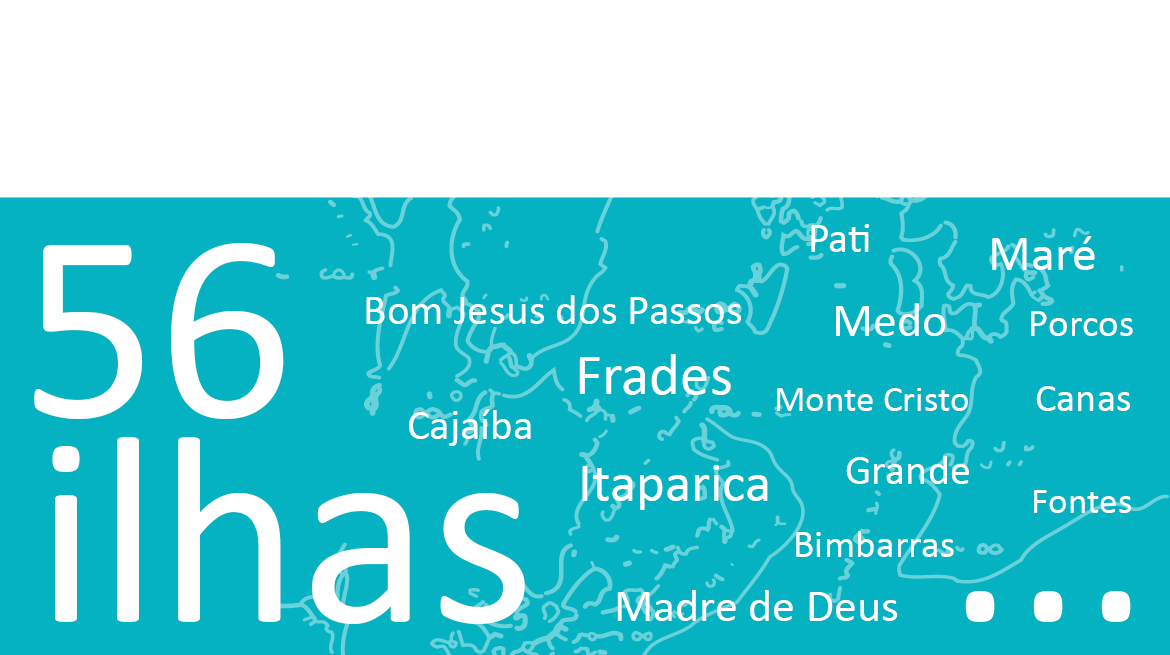Main Islands
Itaparica
Itaparica Island – the biggest one among the 56 existing ones in All Saints Bay – is the most famous and known one. It is not only because of its huge extension (293 km²), but also because the community was a scenery for important facts in the origin of the Portuguese colonization and when Dutch people passed by Bahia. In addition, some people that agree that the Independence of Brazil happened (or started) in Bahia.
Itaparica (from Tupi language “stone fence”) still keeps its marks through its rich cultural patrimony, which is conserved and symbolized by several historical monuments, result of an architecture of several styles throughout the years, like São Lourenço Church that was built in 1610, the Manor in Piedade Square , from the 18th century, Santíssimo Sacramento Church , São Lourenço Fort that was built in 1711 and represents one of the most significant symbols of the struggle for independence, as well as Fonte da Bica Park , from 1842, with excellent mineral water.
The island, of rich tropical vegetation, has become a hot spot for tourists and vacationers because of its undeniable beauty. The 15-km sea-facing coral barrier has naturally created an environment good for leisure, with calm and clear waters and a variety of options for relaxation as bathing , diving , hiking , horseback riding , cycling and water sports.
On August , 1833, Itaparica Island was emancipated from Salvador and on June , 1962 it reached the category of city. As time passed by it was dismembered in two cities, Vera Cruz and Itaparica. Today, Vera Cruz is made of villages and towns such as Penha, Barra Grande, Conceição, and Barra do Gil, Berlinque, Cacha-Prego, Aratuba, Coroa, Barra do Pote, Tairu and Mar Grande. Itaparica hosts the villages of Manguinhos, Ponta de Areia, Amoreiras and Porto Santo.
Frades
The name of the island is yet not known for sure, because of the many codenames it has received since its discovery in the early sixteenth century. There are the ones that call it Paramana, Viração, Loreto or Ponta do Nossa Senhora, but in reality, these names, as time passed by are only of beaches and villages. Nowadays it is definitely and officially known as Frades Island.
Why is that? According to traditions passed by people from that time, at the beginning of that century, a boat with group of friars would have shipwrecked in All Saints Bay and because they swam, they could get to the island. However, literally, all of them ended up dying on the beach because Tupinambás Indians who lived there killed them. Another version authenticates the cannibalism but attributes the debark on the island to the free and spontaneous will of the friars, because of religious matters. Later, the Order of Jesuits owned the island, until the Marquis of Pombal expelled it from Brazil.
Its historical importance can still be traced through the testimonies from the apogee, when the island’s contribution to the supply of the then city of Bahia, was significant. There are some symbols from the social and economic relations of past times , when, for example, in the nineteenth century, it served as a place to await the “tumbeiros” (slave ships that supported the slave trade) and “lazareto” , a kind of warehouse in distant place where slaves or strangers, who were suspect of having contagious diseases, were kept in quarantine. This place also worked for fattening slaves before they were sold. There are also the churches of Nossa Senhora de Loreto Loreto (1645), completely restored by Baía Viva Foundation, and Nossa Senhora de Guadalupe Church also from the 17th century, also re-erected and restored
Madre de Deus
Like almost all the islands of All Saints Bay , the ones that belong to Madre de Deus also have historical importance , starting with its original name, Curupeba (small frog) – a nickname given by Tupinamba Indians, who inhabited it before the arrival of Pedro Álvares Cabral. The island was the stage of foreign invasions and belonged from 1534 on to Mem de Sá’s land grant (third Governor-General of Brazil), until it was donated to the Jesuits during the colonization process. After its expulsion and reintegration to the Crown, the island was then called Freguesia de Madre de Deus do Boqueirão and, in 1584, when it was leased to farmers it finally became only known Madre de Deus.
Since it was halfway the city of Bahia and the sugar mills from the Reconcavo, the island became an important focal point of support for the vessels during the colonization. In 1989, through a State Law, the island was dismembered from Salvador and became a municipality, and Vacas, Maria Guarda and Coroa do Capeta were part of it.
On close and near localities, there can be found the marks of history that had been left in Madre de Deus, highlighting the houses of Laudelino Pinheiro and Pedro Gomes in the square where there are Matriz de Nossa Senhora Church. On the beach of Suape, there is House of Two Lions and the old beach residence of the former governor Antonio Balbino, all of them from the second half of the nineteenth century.
It is not too much to remind that Madre de Deus, in the early twentieth century was the favorite beach of middle class people that lived in Salvador; then there was a radical change with the implementation of the petrol. Industry in the region, in the 50’s – Landulpho Alves Refinery and Marine Terminal from Petrobrás.
Maré
It is the third largest island in All Saints Bay and certainly, it is the closest to Salvador – only twenty minutes far. This partially explains the great number of people who go to the beaches for the weekends. Its exhilarating view is made of palm trees and banana trees, as well as warm and clear waters. Before the lush landscape made up of coconut trees and banana trees, which shelter warm and clear waters. There you can find one of the best places in the bay to swim, especially if you are on the almost desert beach of Botelho, with one of the most beautiful panoramic views of the archipelago.
Maré Island hosts simple houses of native anglers also houses the simple houses of native anglers and lace makers who work with the billet lace, manufacturing blouses dressing gowns, tablecloths and other handmade accessories, a heritage that goes through generation. A culture that has as its symbol Nossa Senhora das Neves Chapel with colonial style and that was built on the XVI Century.
The access to the island takes place through São Tomé do Paripe maritime terminal, where boats leave almost uninterruptedly and, therefore, visited by many residents from the suburbs and the low city, mainly from Ribeira, Itapagipe, Caminho de Areia and Bonfim.
Bom Jesus dos Passos
It is one of the most attractive for its natural beauty. It is located between the islands of Madre de Deus and Frades Bom Jesus dos Passos and calls the attention of the boats that sail in the bay for its fascinating scenery. Everything there, as the blue sky and the clear and calm waters makes you feel as if you were in paradise. It is also the ideal environment for leisure and nautical sports.
However, this pleasant and calm city, in 1624 was resistant to the invasion of Dutch people. Known in the past as Pataíba Assú (or palm wood pati), the island was also inhabited by the Tupinamba Indians, having received, in 1776, the name that designates it today, the date of the construction of its first church. Visitors can also visit some of the relics of the past, such as Duarte Manor, Nossa Senhora da Conceição chapel and Grande and Porrãozinho fountains.
According to reports from residents, the island has already been an important pole for the production of small vessels in All Saints Bay. Many of the boats that are currently used for passengers’ transportation in the northern part of the bay were built in Bom Jesus dos Passos. The activity, however, is in decline and currently only repairs some boats.
As it has already been happening on Frades Island – on a more advanced phase of the work – Baía Viva Foundation has been carrying out works that aim the urban-environmental requalification of Bom Jesus dos Passos.
Medo
Until nowadays, the ruins of the old hospital for lepers and a military barracks that were under operation on the island in the last century can be found. There are many versions to explain its name. There are those who justify it because of some ghosts that lived in the hospital. Another story is about a priest from Itaparica who received gratification to celebrate a mass at the place, but never did it. With his death, his soul was responsible for a celebration with ghostly tones, inviting the natives to attend it.
Medo Island does not have drinking water fountains; it is one of the smallest in the bay (12 thousand m²), belongs to the region of Itaparica and is uninhabited.
Bimbarras
Nowadays, this small island aims to consolidate a project for nautical tourism that includes the whole All Saints Bay. This project is based on a concept of self-sustainability that favors a series of initiatives for the tourism of low density and that at the same time turns this farm into an operative and productive one that focuses on the production of regional fruit trees, mariculture and stockbreeding.
Matarandiba
The island. Is sited near Funil Bridge. This bridge goes from the island to the continent. It is almost mandatory for sailors and yachts people to stop there while sailing on the Coast of Itaparica Island.
Others
Cajaíba, Porcos, Pati, Canas, Fontes, Grande and Monte Cristo.


